
Dr. Joe Schwarcz is Director of McGill University’s Office for Science and Society. He is well known for his informative and entertaining public lectures on topics ranging from the chemistry of love to the science of aging. Dr. Joe has received numerous awards for teaching chemistry and for interpreting science for the public and is the only non-American ever to win the American Chemical Society’s prestigious Grady-Stack Award for demystifying chemistry. He hosts "The Dr. Joe Show" on Montreal's CJAD and has appeared hundreds of times on The Discovery Channel, CTV, CBC, TV Ontario and Global Television. He is also an amateur conjurer and often spices up his presentations with a little magic. Dr. Joe also writes a newspaper column entitled “The Right Chemistry” and has authored a number of books including best-sellers, Radar, Hula Hoops and Playful Pigs, The Genie in the Bottle, The Right Chemistry, An Apple a Day, Is That a Fact?, and Monkeys, Myths, and Molecules. Dr. Joe was awarded the 2010 Montreal Medal, the Canadian Chemical Institute’s premier prize recognizing lifetime contributions to chemistry in Canada. In 2015 he was named winner of the Balles Prize for critical thinking by the US based Committee for Skeptical Inquiry in recognition of his 2014 book, Is That A Fact?.
A Grain of Salt: The Science and Pseudoscience of What We Eat
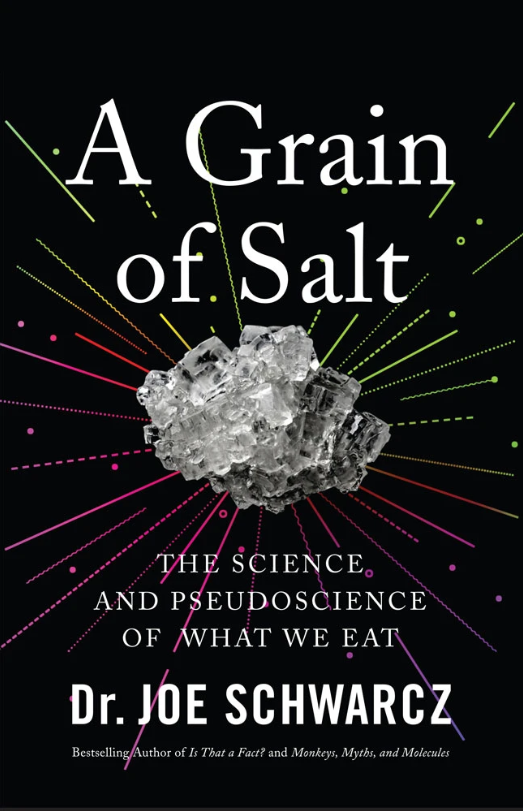 ECW, 2019
ECW, 2019
“This enlightening collection offers every reader something new to learn and marvel over.” — Booklist
Bestselling popular science author Dr. Joe Schwarcz debunks the baloney and serves up the raw facts in this appetizing collection about the things we eat
Eating has become a confusing experience. Should we follow a keto diet? Is sugar the next tobacco? Does fermented cabbage juice cure disease? Are lectins toxic? Is drinking poppy seed tea risky? What’s with probiotics? Can packaging contaminate food? Should our nuts be activated? What is cockroach milk?
We all have questions, and Dr. Joe Schwarcz has the answers, some of which will astonish you. This collection is guaranteed to satisfy your hunger for palatable and relevant scientific information as Dr. Joe separates fact from fiction with an assortment of new and updated articles about what to eat, what not to eat, and how to recognize the scientific basis of food chemistry.
Monkeys, Myths, and Molecules
 ECW, 2015
ECW, 2015
The internet is a powerful beast when it comes to science; the answer to any query you may have is just a few keystrokes away. But when there are multiple answers from various sources, how do we know what information is reliable? In Monkeys, Myths, and Molecules, bestselling author Dr. Joe Schwarcz takes a critical look at how facts are misconstrued in the media. He debunks the myths surrounding canned food, artificial dyes, SPF, homeopathy, cancer, chemicals, and much more.
Unafraid to expose the sheer nonsense people are led to believe about health, food, drugs, and our environment, Dr. Joe confronts pseudoscience and convincingly and entertainingly advocates for a scientific approach to everyday life.
Is That a Fact?
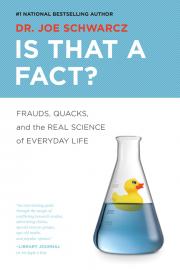 ECW, 2014
ECW, 2014
An entertaining and digestible volume that demystifies science
Eat this and live to 100. Don’t, and die. Today, hyperboles dominate the media, which makes parsing science from fiction an arduous task when deciding what to eat, what chemicals to avoid, and what’s best for the environment. In Is That a Fact?, bestselling author Dr. Joe Schwarcz carefully navigates through the storm of misinformation to help us separate fact from folly and shrewdness from foolishness. Are GMOs really harmful? Or could they help developing countries? Which “miracle weight-loss foods” gained popularity through exuberant data dredging? Is BPA dangerous or just a victim of unforgiving media hype? Is organic better? Dr. Joe questions the reliability and motives of "experts" in this easy-to-understand yet critical look at what’s fact and what’s plain nonsense.
The Right Chemistry
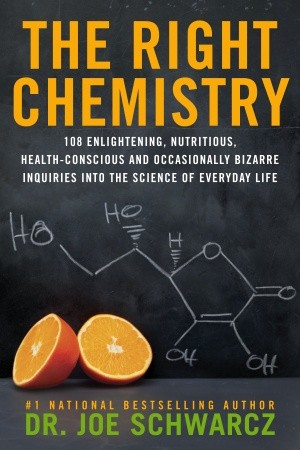 Doubleday Canada, 2012
Doubleday Canada, 2012
A big part of Dr. Joe's job as director of McGill University's Office of Science and Society is persuading people that the pursuit of science knowledge is a potential source of wonder, enlightenment and well-being for everyone. And as a chemist, he's particularly keen to rescue chemistry from the bad rep it's developed over recent decades. There is more to chemistry than toxins, pollution, and "Don't drink that soda—it's full of chemicals."
The evangelic zeal Dr. Joe brings to his day job is of course also the driving force behind his work as an author. Once again, here he is to tell that everything is full of chemicals, and that chemistry means health, nutrition, beauty products, cleaning products, DNA, and the means by which Lady Gaga's meat dress was held together.
In the style established with the bestselling Brain Fuel, each section here is themed and contains a mixture of short, pithy items and slightly longer mini-essays. And as before—but never with such energy and relish—Dr. Joe goes on the attack against charlatans in the alternative health trade, naming and shaming them in a particularly entertaining and edifying section of the book called "Claptrap."
You will learn whether to put broccoli on a pizza before or after baking, whether beauty pills are worth taking, and whether the baby shampoo you're using is poisonous. You will discover but not use, please, the recipe for a Molotov cocktail. You will be enabled to enthrall fellow dinner guests with the derivation of the name Persil, and the definition of a kangarian (it's someone who only eats kangaroo meat).
As ever, this torrent of entertainment is delivered in Dr. Joe's unmistakably warm, lively and authorative voice.
Dr. Joe's Brain Sparks:
179 Inspiring and Enlightening Inquiries into the Science of Everyday Life
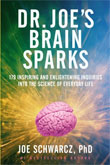
Doubleday Canada, 2010
Prepare to be amazed once again.
Did you know what when you shake a ketchup bottle you're practicing thixotropy? That the ancient Greeks made themselves look less ancient by inventing moisturizer? That the mysterious drug obecalp* is as effective as homeopathy and many herbal cures? From the bestselling author of An Apple a Day, Brain Fuel, and Science, Sense and Nonsense comes a fresh batch of inquiries into the science of everyday life. Dr. Joe, as he is affectionately known to millions of readers, listeners, viewers, and students, presents his third book in the Doubleday Canada series he launched with Brain Fuel.
Using a Q&A format, it explains the world through science, and science through our common experience. There are sections on diet and nutrition, new drugs, and the dubious claims made for alternative remedies and beauty potions. There is a profusion of inspiring, enlightening, sometime just downright bizarre information drawn from the laboratory, from history, from our medicine cabinets and the bottles under our sinks. Science is everywhere, and Dr. Joe is keeping track - and doing it in a marvelously warm, eminently readable style. Let the brain sparks fly!
*Try reading this word backwards.
From the Trade Paperback edition.
Science, Sense, and Nonsense: 61 Nourishing, Healthy, Bunk-Free Commentaries on the Chemistry That Affects Us All
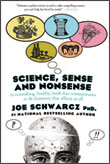 Doubleday Canada, 2009
Doubleday Canada, 2009
When did "chemical" become a dirty word?
Forty or so years ago, chemistry - which had been recognized as a miracle-making boon to humanity - somehow became associated with warfare, sinister food additives, "toxins" and pollution.
It's a situation that Dr. Joe Schwarcz aims to put into perspective.
Yes, there's a downside to chemistry, he says, but this is dwarfed by its enormous benefits.
Dr. Joe's new collection of commentaries will inspire an appreciation for the science of everyday life, and equip you to spot the muddled thinking, misunderstandings and deceptions in media stories and advertising claims. Does organic food really always equal better food? Are vaccines dangerous? Will the latest health fad make you ill? Do expensive wrinkle creams do the job? What are the best ways to avoid cancer? The answers to such questions often lie in an understanding of the chemistry involved. Ask Dr. Joe.
Science, Sense and Nonsense celebrates chemistry's great achievements, lambastes its charlatans, and explores its essential connections to our wellbeing. And does so in authoritative, highly readable, good humoured style.
Brain Fuel:
199 Mind-Expanding Inquiries into the Science of Everyday Life
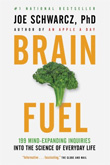 Anchor Canada, Paperback Edition, 2010
Anchor Canada, Paperback Edition, 2010
As with Dr. Joe’s previous best-selling books, Brain Fuel informs and entertains on a wild assortment of science-based topics. But this is not "science trivia." If you are looking for serious scientific discussions, you’ll find them here. If you are looking for practical consumer information, that’s here too. If you are searching for ways to stimulate interest in science, look no further, Mom. And if you are simply wondering why the birth of Prince Leopold was so different from Queen Victoria's previous seven; or why an iron rod that went through a man's head is now on display in a museum in Boston; or why white chocolate has such a short shelf life; or why eggs terrified Alfred Hitchcock – and what all of this means for the rest of us, and why – then bingo.
“Falling in love, we all know, is a matter of the right chemistry. Schwarcz gets his chemistry right, and hooks his readers.”
— John C. Polanyi, Nobel Laureate
“Informative [and] fascinating.”
— The Globe and Mail
An Apple a Day:
The Myths, Misconceptions and Outright Exaggerations
about Diet, Nutrition and the Foods We Eat

 HarperCollins Publishers, 2007
HarperCollins Publishers, 2007
Eat salmon. It’s full of good omega-3 fats. Don’t eat salmon. It’s full of PCBs and mercury. Eat more veggies. They’re full of good antioxidants. Don’t eat more veggies. The pesticides will give you cancer.
Forget your dinner jacket and put on your lab coat: you have to be a nutritional scientist these days before you sit down to eat—which is why we need Dr. Joe Schwarcz, the expert who’s famous for connecting chemistry to everyday life. In An Apple a Day, he’s taken his thorough knowledge of food chemistry, applied it to today’s top food fears, trends and questions, and leavened it with his trademark lighthearted approach. The result is both an entertaining revelation of the miracles of science happening in our bodies every time we bite into a morsel of food, and a telling exploration of the myths, claims and misconceptions surrounding our obsession with diets, nutrition and weight.
Looking first at how food affects our health, Dr. Joe examines what’s in tomatoes, soy and broccoli that can keep us healthy and how the hundreds of compounds in a single food react when they hit our bodies. Then he investigates how we manipulate our food supply, delving into the science of food additives and what benefits we might realize from adding bacteria to certain foods. He clears up the confusion about contaminants, examining everything from pesticide residues, remnants of antibiotics, the dreaded trans fats and chemicals that may leach from cookware. And he takes a studied look at the science of calories and weighs in on popular diets.
An Apple a Day is a must-read book for anyone who looks forward to digesting the truth about what we eat.
Let Them Eat Flax:
70 All-New Commentaries on the Science of Everyday Food & Life
 ECW, 2005
ECW, 2005
Chemistry, according to Joe Schwarcz, is the thread that ties life together. Foods, drugs and cosmetics yield their secrets as their chemical composition is explored. In his latest work, “Let Them Eat Flax,” Schwarcz continues to reveal the mysteries of the chemistry of daily life in his inimatable style, blending modern science with history, always with a bit of whimsy thrown in. He investigates a broad range of subjects ranging from the labeling of foods to the chemistry of crime. Schwarcz gives credit when it is due, as in the development of penicillin or paper, but does not hesitate to poke fun at the quackery involved in promoting “vitamin O” or “living enzymes.” Along with a myriad of other topics, the reader learns about the chemistry of depression, the questionnable claims about “natural remedies,” the risks of chiropractic, the nuances of smoked meat and, of course, about the scientific issues behind “let them eat flax” and other such bits of wisdom that “they say.”
Dr. Joe & What You Didn't Know:
99 Fascinating Questions about the Chemistry of Everyday Life
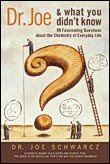 ECW, 2003
ECW, 2003
Linus Pauling, one of the most celebrated scientists of the twentieth century, once remarked that satisfying curiosity is one of the greatest sources of pleasure in life. Dr. Joe and What You Didn’t Know aims to act as both the source and satiation of such curiosity, providing pleasure through a series of 99 chemistry-related questions and answers designed to both inform and entertain. Ranging from the esoteric to the everyday, Dr. Joe Schwarcz tackles topics from Beethoven’s connection to plumbing to why rotten eggs smell like rotten eggs.
The Fly in the intment
63 Fascinating Commentaries on the Science of Everyday Life
 ECW, 2004
ECW, 2004
Hot on the heels of his previous bestsellers, award-winning author Dr. Joe Schwarcz’s latest book, The Fly in the Ointment, doesn’t disappoint. From pesticides and environmental estrogens to lipsticks and garlic, Dr. Joe is back to demystify the science that surrounds us. Why do some people drill holes in their heads for “enlightenment”? How did a small chemical error nearly convict the unfortunate Patricia Stallings for murdering her son? Where does the expression “take a bromide” come from? Schwarcz investigates aphrodisiacs, ddt, bottled water, vitamins, barbiturates, plastic wrap, and smoked meat. He puts worries about acrylamide, preservatives, and waxed fruit into perspective and unravels the mysteries of bulletproof vests, weight loss diets, and “mad honey.” From the fanciful to the factual, Dr. Joe Schwarcz enlightens us all — no drills attached.
That's The Way the Cookie Crumbles
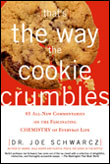 ECW, 2002
ECW, 2002
Interesting anecdotes and engaging tales make science fun, meaningful, and accessible. Separating sense from nonsense and fact from myth, these essays cover everything from the ups of helium to the downs of drain cleaners and provide answers to numerous mysteries, such as why bug juice is used to colour ice cream and how spies used secret inks. Mercury in teeth, arsenic in water, lead in the environment, and aspartame in food are discussed.
The Genie in the Bottle
 ECW, 2001
ECW, 2001
Get a different twist on licorice and travel to the dark side of the sun. Control stinky feet and bend spoons and minds. Learn about the latest on chocolate research, flax, ginkgo biloba, magnesium, and blueberries. Read about the ups of helium and the downs of drain cleaners. Find out why bug juice is used to colour ice cream, how spies used secret inks, and how acetone changed the course of history. It’s all there! “Dr. Joe” also solves the mystery of the exploding shrimp and, finally, he lets us in on the secret of the genie in the bottle.
Radar, Hula Hoops and Playful Pigs
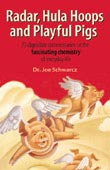 ECW, 1999
ECW, 1999
Radar, Hula Hoops, and Playful Pigs really does "tell it like it is" in 67 short, entertaining, and informative pieces about chemistry in everyday life. Find out the latest about homeopathy and alternative medicine. Fill up on facts about soybeans, tomatoes, tea, ginseng, chicken soup, hot dogs, and the benefits of eating chalk. Explore the science behind Alice’s strange adventures in Wonderland, Rumpole’s deadly cheese soufflé, and Casanova’s experiments with "Spanish Fly." Investigate the nefarious chemistry of the KGB, the colors of urine, and the mysteries of baldness.

